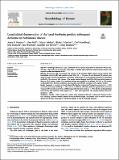Por favor, use este identificador para citar o enlazar a este item:
http://hdl.handle.net/10261/236352COMPARTIR / EXPORTAR:
 SHARE SHARE
 CORE
BASE CORE
BASE
|
|
| Visualizar otros formatos: MARC | Dublin Core | RDF | ORE | MODS | METS | DIDL | DATACITE | |

| Título: | Longitudinal degeneration of the basal forebrain predicts subsequent dementia in Parkinson's disease |
Autor: | Pereira, Joana B.; Hall, Sara; Jalakas, Mattis; Grothe, Michel J. CSIC ORCID; Strandberg, Olof T.; Stomrud, Erik; Westman, Eric; van Westen, Danielle; Hansson, Oskar | Palabras clave: | Parkinson's disease Dementia Basal forebrain Longitudinal MRI Cognitive decline |
Fecha de publicación: | jun-2020 | Editor: | Elsevier | Citación: | Neurobiology of Disease 139: 104831 (2020) | Resumen: | [Objectives] Cholinergic dysfunction plays a prominent role in cognitive impairment in Parkinson's disease (PD). The aim of this study was to assess the relationship of baseline and longitudinal basal forebrain atrophy with cognitive decline and dementia in PD. [Methods] We included 106 non-demented PD patients, 19 PD dementia (PDD) patients and 42 controls with longitudinal structural MRI and cognitive testing. After 4.2 ± 1.8 years, 20 non-demented PD patients were diagnosed with dementia (PD-dementia converters), whereas the rest of PD patients remained non-demented (stable-PD). We compared MRI volumes of the medial septum/diagonal band (Ch1/Ch2) and nucleus basalis of Meynert (Ch4) between groups. Cox regression analyses were applied to test whether Ch1/Ch2 or Ch4 atrophy could predict future dementia and linear mixed models assessed their association with cognitive decline. [Results] Compared to controls, we found reduced Ch4 baseline volumes in PD-dementia converters (p = .003) and those who already had PDD (p < .001) but not in stable-PD. Over time, there was a greater loss in Ch1/Ch2 volumes in PD-dementia converters and PDD compared to the other groups (p = .004). Baseline and longitudinal Ch4 volumes were associated with cognition (p < .002) and longitudinal Ch4 atrophy predicted future dementia (p = .009). [Conclusions] Atrophy of Ch4 precedes and predicts future dementia in PD and is followed by changes in Ch1/Ch2, reflecting a posterior-anterior pattern of basal forebrain atrophy. This pattern could be used to track the spread of cholinergic degeneration and identify patients at risk of developing dementia. |
Versión del editor: | http://doi.org/10.1016/j.nbd.2020.104831 | URI: | http://hdl.handle.net/10261/236352 | DOI: | 10.1016/j.nbd.2020.104831 | Identificadores: | doi: 10.1016/j.nbd.2020.104831 issn: 0969-9961 |
| Aparece en las colecciones: | (IBIS) Artículos |
Ficheros en este ítem:
| Fichero | Descripción | Tamaño | Formato | |
|---|---|---|---|---|
| Parkinsons_disease.pdf | 811,13 kB | Adobe PDF |  Visualizar/Abrir |
CORE Recommender
SCOPUSTM
Citations
46
checked on 04-may-2024
WEB OF SCIENCETM
Citations
38
checked on 22-feb-2024
Page view(s)
83
checked on 06-may-2024
Download(s)
119
checked on 06-may-2024
Google ScholarTM
Check
Altmetric
Altmetric
Este item está licenciado bajo una Licencia Creative Commons

